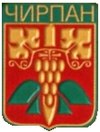Chirpan
| Chirpan (Чирпан) | |||
|
|||
| Basic data | |||
|---|---|---|---|
| State : |
|
||
| Oblast : | Stara Sagora | ||
| Residents : | 14,377 (December 31, 2016) | ||
| Coordinates : | 42 ° 12 ′ N , 25 ° 20 ′ E | ||
| Height : | 168 m | ||
| Postal code : | 6200 | ||
| Telephone code : | (+359) 0416 | ||
| License plate : | CT | ||
| Administration (status: 2011-) | |||
| Mayor : | Kitschka Petkova | ||
| Ruling party : | Bulgarian Socialist Party | ||
| Website : | www.chirpan.bg | ||

Tschirpan [ tʃirˈpan ] ( Bulgarian Чирпан ) is a city in central Bulgaria in the heart of Thrace . Tschirpan is the administrative center of the municipality of Tschirpan.
location
Tschirpan is located on the southern foothills of the elevation Tschirpan Heights (Bulgarian Чирпанските възвишения, 651 m).
In Stara Sagora Oblast, Chirpan is the third largest city after Stara Sagora and Kazanlak . Tschirpan is 39 km southwest of Stara Sagora and 50 km east of Plovdiv . The Tschirpan train station is on the important Plovdiv - Burgas railway line .
The climate is temperate continental with slight Mediterranean influences. The precipitation amounts to approx. 700 mm per year.
Attractions
- the Pejo Jaworow museum house (Пейо Яворов)
- Nikola Manev Gallery (Никола Манев)
- the Sveti Atanasij (Свети Атанасий) monastery in the village of Slatna Livada (Златна ливада)
- the archaeological excavation site Karasura (Roman road station, medieval fortress, only foundations left) near the village of Rupkite
- the historical museum
- the churches of Sweta Bogorodiza (Света Богородица), Sweti Archangel Michail (Свети Архангел Михаил), Sweti Kiril i Metodij (Свети Свети Свети Кирил и Свети Кирил и Свети Кирил и Свети Кирил и Светиетий.
economy
Up until 1989, mechanical engineering (hydraulic systems, machines for the food industry), the textile industry (confectionery) and wine production (Winprom - very large sparkling wine production) were developed in Tschirpan.
After 1989 (the year of the turnaround in Bulgaria) the local economy deteriorated due to a lack of raw materials and structural problems. The cosmetics industry is currently developing well.
history
Tschirpan is the successor to the ancient Roman settlement Scherampol (bulg. Шерампол), which was near the Roman way station Pizo (7 km outside of today's Tschirpan) - near the village Dimitriewo (bulg. Димитриево). The current city of Tschirpan was founded at the beginning of the 15th century.
The name Chirpan comes from the Roman name of the settlement and is associated with the spring Tekir (Текир), around which the city arose.
In the 18th and 19th centuries, during the period of the Bulgarian Revival , the town had a well-developed craft and agriculture.
After the Russo-Turkish War (1877–1878) , which brought the end of Ottoman rule, the city played a leading role in the struggle for the reunification of the whole of Bulgaria. The city's public holiday (6 September annually) is celebrated on the day of reunification (Ден на Съединението).
Because of the loss of sales markets in the Ottoman Empire, the handicrafts in the city fell into disuse after 1878. In return, viticulture and wine production flourished.
Since 2005, the city has given its name to Chirpan Peak , a mountain on Livingston Island in Antarctica.
Culture
The annual Jaworow Days, dedicated to the works of the famous poet, take place from January 13-15. September 6th is the annual city holiday and autumn fair. On September 17th the artist Nikola Manev celebrates its holidays.
Famous sons and daughters
- Georgi Danchov - Zografina (1846–1908), painter, friend and helper of Vasil Levski
- Stojan Zaimow (1853-1932), Bulgarian revolutionary, freedom fighter and leader of the April uprising (1876)
- Pejo Jaworow (1878–1914), Bulgarian poet and revolutionary fighter, founder of Bulgarian symbolism
- Atanaska Todorova (1896–1979), folk singer
- Ivan Dimow (1897-1965), actor and actor in theater, film and television
- Pimen von Newrokop (1906–1999), high cleric of the Orthodox Church, metropolitan
- Dimitar Danailov (1921–1992), Bulgarian poet, friends with the singer Vladimir Vysotsky
- Nikola Manew (* 1940), Bulgarian painter and artist, lives in Paris
- Ivan Kolew (* 1951), wrestler, world and European champion
- Mira Todorova (* 1994), volleyball player

